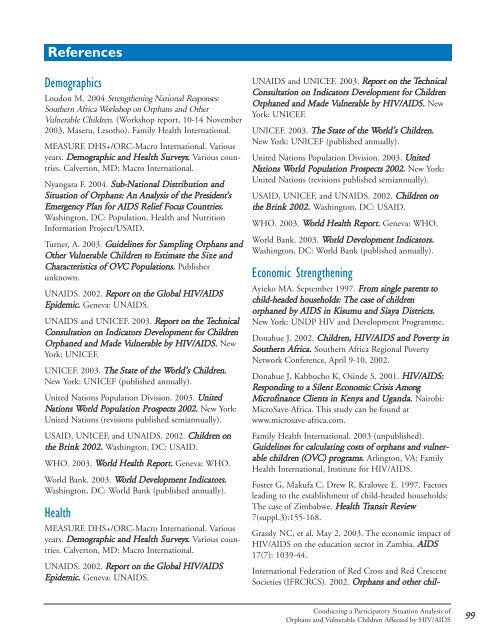Conducting a Participatory Situation Analysis of.pdf - Global HIV ...
Conducting a Participatory Situation Analysis of.pdf - Global HIV ...
Conducting a Participatory Situation Analysis of.pdf - Global HIV ...
Create successful ePaper yourself
Turn your PDF publications into a flip-book with our unique Google optimized e-Paper software.
References<br />
Demographics<br />
Loudon M. 2004 Strengthening National Responses:<br />
Southern Africa Workshop on Orphans and Other<br />
Vulnerable Children. (Workshop report, 10-14 November<br />
2003, Maseru, Lesotho). Family Health International.<br />
MEASURE DHS+/ORC-Macro International. Various<br />
years. Demographic and Health Surveys. Various countries.<br />
Calverton, MD: Macro International.<br />
Nyangara F. 2004. Sub-National Distribution and<br />
<strong>Situation</strong> <strong>of</strong> Orphans: An <strong>Analysis</strong> <strong>of</strong> the President’s<br />
Emergency Plan for AIDS Relief Focus Countries.<br />
Washington, DC: Population, Health and Nutrition<br />
Information Project/USAID.<br />
Turner, A. 2003. Guidelines for Sampling Orphans and<br />
Other Vulnerable Children to Estimate the Size and<br />
Characteristics <strong>of</strong> OVC Populations. Publisher<br />
unknown.<br />
UNAIDS. 2002. Report on the <strong>Global</strong> <strong>HIV</strong>/AIDS<br />
Epidemic. Geneva: UNAIDS.<br />
UNAIDS and UNICEF. 2003. Report on the Technical<br />
Consultation on Indicators Development for Children<br />
Orphaned and Made Vulnerable by <strong>HIV</strong>/AIDS. New<br />
York: UNICEF.<br />
UNICEF. 2003. The State <strong>of</strong> the World’s Children.<br />
New York: UNICEF (published annually).<br />
United Nations Population Division. 2003. United<br />
Nations World Population Prospects 2002. New York:<br />
United Nations (revisions published semiannually).<br />
USAID, UNICEF, and UNAIDS. 2002. Children on<br />
the Brink 2002. Washington, DC: USAID.<br />
WHO. 2003. World Health Report. Geneva: WHO.<br />
World Bank. 2003. World Development Indicators.<br />
Washington, DC: World Bank (published annually).<br />
Health<br />
MEASURE DHS+/ORC-Macro International. Various<br />
years. Demographic and Health Surveys. Various countries.<br />
Calverton, MD: Macro International.<br />
UNAIDS. 2002. Report on the <strong>Global</strong> <strong>HIV</strong>/AIDS<br />
Epidemic. Geneva: UNAIDS.<br />
UNAIDS and UNICEF. 2003. Report on the Technical<br />
Consultation on Indicators Development for Children<br />
Orphaned and Made Vulnerable by <strong>HIV</strong>/AIDS. New<br />
York: UNICEF.<br />
UNICEF. 2003. The State <strong>of</strong> the World’s Children.<br />
New York: UNICEF (published annually).<br />
United Nations Population Division. 2003. United<br />
Nations World Population Prospects 2002. New York:<br />
United Nations (revisions published semiannually).<br />
USAID, UNICEF, and UNAIDS. 2002. Children on<br />
the Brink 2002. Washington, DC: USAID.<br />
WHO. 2003. World Health Report. Geneva: WHO.<br />
World Bank. 2003. World Development Indicators.<br />
Washington, DC: World Bank (published annually).<br />
Economic Strengthening<br />
Ayieko MA. September 1997. From single parents to<br />
child-headed households: The case <strong>of</strong> children<br />
orphaned by AIDS in Kisumu and Siaya Districts.<br />
New York: UNDP <strong>HIV</strong> and Development Programme.<br />
Donahue J. 2002. Children, <strong>HIV</strong>/AIDS and Poverty in<br />
Southern Africa. Southern Africa Regional Poverty<br />
Network Conference, April 9-10, 2002.<br />
Donahue J, Kabbucho K, Osinde S. 2001. <strong>HIV</strong>/AIDS:<br />
Responding to a Silent Economic Crisis Among<br />
Micr<strong>of</strong>inance Clients in Kenya and Uganda. Nairobi:<br />
MicroSave-Africa. This study can be found at<br />
www.microsave-africa.com.<br />
Family Health International. 2003 (unpublished).<br />
Guidelines for calculating costs <strong>of</strong> orphans and vulnerable<br />
children (OVC) programs. Arlington, VA: Family<br />
Health International, Institute for <strong>HIV</strong>/AIDS.<br />
Foster G, Makufa C, Drew R, Kralovec E. 1997. Factors<br />
leading to the establishment <strong>of</strong> child-headed households:<br />
The case <strong>of</strong> Zimbabwe. Health Transit Review<br />
7(suppl.3):155-168.<br />
Grassly NC, et al. May 2, 2003. The economic impact <strong>of</strong><br />
<strong>HIV</strong>/AIDS on the education sector in Zambia. AIDS<br />
17(7): 1039-44.<br />
International Federation <strong>of</strong> Red Cross and Red Crescent<br />
Societies (IFRCRCS). 2002. Orphans and other chil-<br />
<strong>Conducting</strong> a <strong>Participatory</strong> <strong>Situation</strong> <strong>Analysis</strong> <strong>of</strong><br />
Orphans and Vulnerable Children Affected by <strong>HIV</strong>/AIDS<br />
99















